|
|

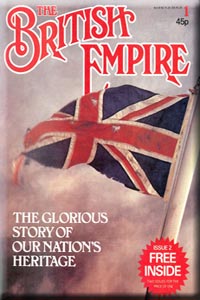 |
The Presence that Changed the World: This introductory issue charts the rise and fall of the empire. It then asks what the full impact was of the largest empire the world had ever known? |
||||
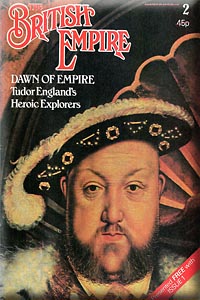 |
Dawn of Empire: Optimism, aggressiveness and self-confidence define Henry VIII and a growing band of hungry explorers Searchers for Cathay: As news returned of a New World, England sought new lands for herself. Picture Essay - Children of Paradise: John White's recording of the coastal Indians of the New World. The Birth of Greater Britain: Settlers aim to turn their dreams for the New World into reality. |
||||
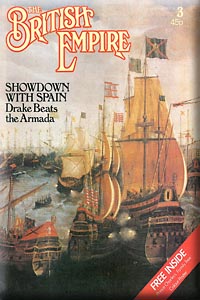 |
Showdown with Spain: Catholic Spain and Protestant England come to blows as religion and politics makes a deadly combination. The Dragon of the Spanish Main:Sir Francis Drake would become a thorn in the side of the Spanish as he sought to find the source of their riches. The Embattled Tudors:Elizabeth had inherited a nation that had veered from one crisis to another for decades. Could she settle the raging storm? The Great Armada: How the most massive force in Naval history failed in its attempt to land an army in England. |
||||
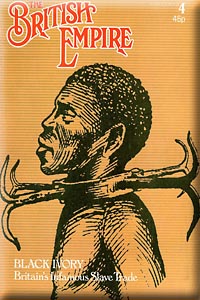 |
Black Ivory: For 300 years, Europeans conducted a sordid trade, sending untold millions of West Africa negroes - 'black ivory' - into slavery across the Atlantic. Picture Essay - A Corrupting Influence:How the trade corrupted all who touched it, from the Africans providing the slaves to the Europeans transporting the cargo to the recipients in the New World. Picture Essay - The Human Animals:From the moment the red-hot trade-marks seared their skin, slaves were the helpless victims of their master's whims. The Dividends of Slavery: The men (and they usually were men) who grew rich on the backs of the labour of their slaves. |
||||
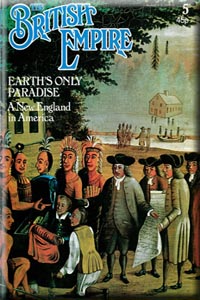 |
Earth's Only Paradise: England muscles in over the Spanish hold on the New World. Their settlements will shape the future of The British Empire as they bring their commerce and agriculture to the new continent. The Pilgrims' London: What had the pilgrims sacrificed and left behind as they entered the New World. Two Differing Nations: The colonies of Massachusetts and Virginia contrasted sharply in their aims and values. Whether they be religious pioneers or secular fortune seekers, the imprint of both sets of settlers would play their decisive part in shaping the New World. The Divine Weed: Tobacco would prove to be the bounty and the cash crop of the Americas. Making fortunes from its addictive nature. A Patchwork of Sects: Many versions of Christianity, particularly within Protestantism, would welcome the new found freedom to establish their 'ideal' communities. |
||||
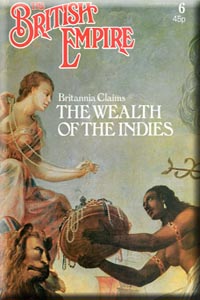 |
The Wealth of the Indies: How Elizabethan sailors vied with Spanish, Dutch and French sailors for control of the bounty of the East. Picture Essay - Exotic Novelties from the East:The spices that fetched fortunes for those who could transport them back to Europe. On the Brink of Disaster: It is the Dutch who become the serious rivals for control of the spice trade. Picture Essay - The East India Company: The Crown Company that dominated the East Indies Trade. The First Steps to Empire: How a trading company turned into an instrument of control and administration. |
||||
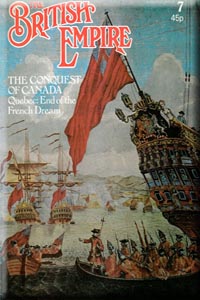 |
The Conquest of Canada: The Seven Years War becomes the French and Indian War as the British and French struggle for mastery over the Great Lakes region. The Hudson's Bay Company:The Trading Company that ruled over an area as large as Europe. Quebec: Wolfe's desperate gamble to dislodge the French from their stronghold. It would settle the fate of the Continent. The Growing Pains of a Young Country: The American Settlers were becoming more testy as the removal of the French threat made them more willing to test their relationship with Britain. No Quarter for Rebellion: French Canadians led by Papineau rebel only to be crushed by decisive British action. A Painful Loosening of Old Bonds: The Durham Report gives a surprising amount of autonomy to the Canadian Colony. |
||||
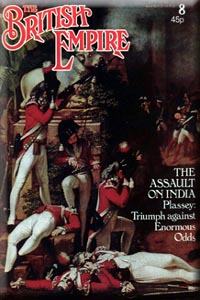 |
The Assault on India: Details how the small, nimble East India Company out-manouevered its rivals to gain supremacy in the sub-continent. Into the Black Hole: Clive battles Suraj-ud-Daula for control of Calcutta. The Walkover at Plassey: How 3,000 disciplined soldiers saw off an army of 50,000 The Spoils of Victory: How the military victories were converted into economic power and gain. The Tiger of Mysore: Tipu Sahib offered a serious challenge to the East India Company at the end of the Eighteenth Century. |
||||
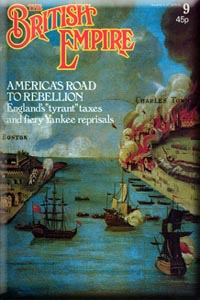 |
America's Road to Rebellion: England's efforts to restore her war shattered economy by taxing Americans - and the colonists' own determination not to pay up. Picture Essay - A Flourishing New Country: The wealthy plantation owners, the rising merchants and independent farmers who, though admiring England, would no longer be bound by her dictates. To the Brink of War: A spiral of bitterness, fed by oppressive taxation, dissident mobs, murderous reprisals and finally the crowning insult of the Boston Tea Party. Picture Essay - The First Blows for Freedom: Bitter words and mob rule turn to all out violence as the Americans draw first blood at Lexington and Concord. The Decision to Rebel: Tom Paine's clear-cut writings act as a clarion call to revolutionaries, who commit themselves to all out war for independence. |
||||
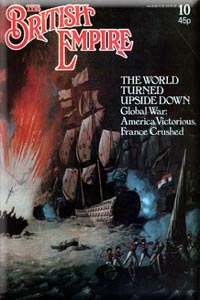 |
The World Turned Upside Down: Rebellion in America flares into all out war - marked by appalling British planning and disasters. Picture Essay - America Breaks Away: British victory in New York is offset by John Paul Jones's freebooting raids on the British coast and by the crushing American victory at Yorktown. The Frightful Strain of Global War: The American War becomes a world war as Britain's enemies - France, Spain and Holland - seize their chance to fulfil long standing ambitions. Picture Essay - The Battle of the Nile: Nelson's devastating victory over Napoleon's fleet which made the Mediterranean an English sea. A Burgeoning Empire: The final victories which established Britain as the supreme imperial power of the new century. |
||||
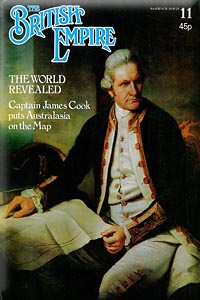 |
The World Revealed: The 18th Century's scant knowledge of the Pacific, Captain James Cook's first two voyages into this unknown region and his charting of Australia and New Zealand. Picture Essay - Endeavour, Resolution and Discovery: The names of Cook's vessels aptly summarize his outward qualities - but not the driving ambition which inspired his explorations of Australasia, the Pacific, and the polar regions. The Gentle Navigator's Last Voyage: From the warmth of the beloved Pacific isles, Cook, tired and becoming careless, probes the Arctic wastes and returns to violent death in Hawaii. |
||||
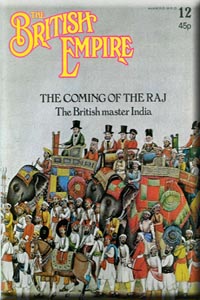 |
The Coming of the Raj: The spoils which many English - and some found - in the heady era following Clive's victory at Plassey. Picture Essay - Through Indian Eyes: Pictures commissioned from Indian artists by the English to commemorate their way of life. The Battle against Corruption: The first controls imposed by London and the furore which surrounded Warren Hasting's impeachment for corruption. "Splendid Sloth and Languid Debauchery": The impossible task facing those who attempted to impose humanity and good government o the British in India. Picture Essay - Skinner's Horse: The story of the half-caste who won an Empire wide reputation with his own irregular cavalry regiment. Wellesley's 'Grand Design': The beginnings of the hard fought British expansion of control over the rest of India. |
||||
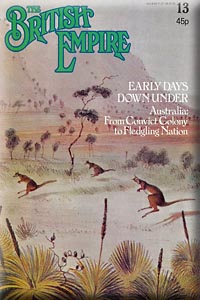 |
Early Days Down Unde: The arrival of the first batch of convicts at Botany Bay and a review of the forbidding continent which they were to face. Picture Essay - A Cruel, Hostile World: Confronted by hostile Aborigines and with their own stores almost gone, the colonists for two years faced extinction. The Struggle for Survival: The arrival of more convict ships and of the first free settlers who assured the colony's success. Picture Essay - A Green and Pleasant Land: In the 1830s the coatal lands of South Australia attracted a mass of settlers who rapidly created thriving new settlements. The Last of the Convicts: Independent minded Australians demanded an end to the convict system - and set themselves on the road to nationhood. |
||||
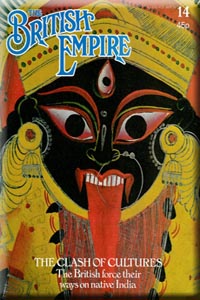 |
The Clash of Cultures: The British begin to eradicate the social evils in their newly acquired Indian Empire: the murder of girl babies, the burning of widows, the Thugs. Picture Essay - Holy Murder: The Thugs's age-old method of slaughter and the campaign, headed by Sir William 'Thuggee' Sleeman, to stamp out their practices. The Assault on Traditional India: The coming of English law and education, of canals and roads, as the British try to recreate Indian society according to their own ideaas of civilisation. Picture Essay - India's 'Grand Abomination': The Hindu and Muslim practices - one of them particularly grisly - which came under assault by reforming British Christians. The Seeds of Rebellion: The new spate of unsettling innovations by Lord Dalhousie and his series of annexations which left India ripe for revolt. |
||||
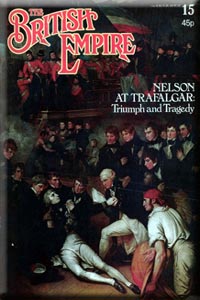 |
Nelson at Trafalgar - Triumph and Tragedy: The life of Britain's greatest naval hero up to the eve of Trafalgar, his greatest battle. HMS Victory's Self-Contained World: Nelson's ship: her cabins, her crowded, unhealthy gun decks and the life of her crew members. The Clash of the Fleets: The British and the Franco-Spanish vessels meet off Trafalgar in the battle which established Britain as the world's dominant sea-power. Memories of a Hero: A variety of souvenirs that were made and purchased by Nelson's deeply saddened countrymen. 'Remember Nelson!': The legacy of respect for Nelson and his achievements which both inspired and inhibited the 19th Century Navy. |
||||
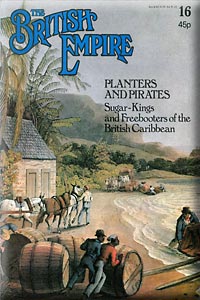 |
Planters and Pirates: The arrival of the British in West Indies, their struggles against the Spanish, the 'white slavery' of indentured labour and Cromwell's disastrous Caribbean campaign against the Spanish. Picture Essay - Under the Jolly Roger: Some of the pirates and privateers whose bloodthirsty ventures made them legends in their own lifetime. "King Sugar" and the Sugar Kings: The men whose vast slave-based sugar estates made them among the richest and most influential men in Britain. Picture Essay - Slaves, Sugar, Rum: a Recipe for Wealth: The back-breaking work of the slaves on a sugar plantation as they plant sugar-cane, harvest it and produce sugar and rum. Decline and Fall: The end of slavery and stiff competition from sugar-growers elsewhere turns many West Indian islands into backwaters. |
||||
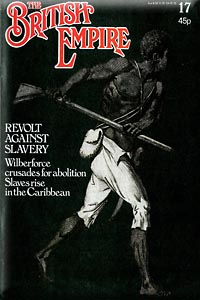 |
Revolt against Slavery: The slow dawn of anti-slavery sentiment in Britain and Granville Sharp's fight for negro rights under the law. Picture Essay - Insurrection: The brutally suppressed negro revolts in Jamaica and Demerara that convinced many at home of the evils of slavery. A gruelling Campaign: The long struggle, headed by William Wilberforce, that in 1807 - after 18 years of angry debate - led t the end of the slave-trade in the Empire. Picture Essay - Mission of Mercy: The anti-slaving voyage of the Linnet, one of the many naval vessels used to suppress the international slave trade. Breaking the Bonds: The rising tide of public opinion finally forces through the measure which outlawed slavery throughout the Empire. |
||||
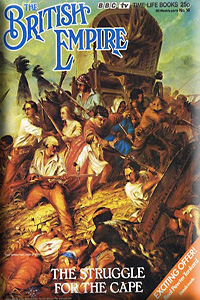 |
The Struggle for the Cape: The arrival of British troops in southern Africa and their reception by the Boer farmers. Picture Essay - The Edge of Civilization: The life of the primitive Bushmen who were gradually pushed into ever remoter areas by advancing Europeans and Bantus. A Patchwork of Peoples:Bushmen, Bantu, Boers and finally the British, now in South Africa to stay, were all rivals for the southern tip of Africa. Picture Essay - Colonizing the Cape: The first British settlers arrive in an officially backed attempt to populate inland areas. Expanding the Frontier: Autocratic British rule determines thousands of Boers to undertake the Great trek inland in search of independence. Picture Essay - A Warrior Society: The life of the warlike Zulus, whose empire was soon to be challenged by Europeans. Into the Jaws of Death: The Boers clash with the Zulus, and terrible massacres by both sides end with the Boers victorious and the foundation of three Boer states. |
||||
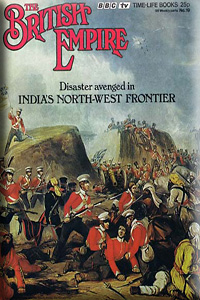 |
North-West Frontier The Russian "menace" to north-west India and the attempt to turn Afghanistan into a puppet-state. Picture Essay - Retreat from Kabul: The ignominious withdrawal of 16,000 people to wholesale destruction in the Afghan mountains. Defeat and Retribution: The disaster is followed by a campaign of revenge and, within a few years, further wars to seize Sind and the Punjab. Picture Essay - Sealing the Border: Two victorious wars put the Punjab, the last independent area in India, under British control and gave India a secure north-west frontier. The Rule of the Sword: The tough, ruthless - but much-respected - administration established by a small, legendary team in the newly conquered area. |
||||
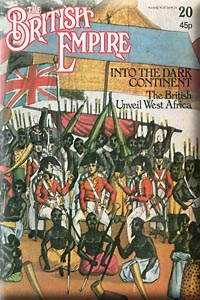 |
Into the Dark Continent: Early British interest in unknown Africa and the first attempts at systematic exploration. Mungo Park's two epic journeys. Picture Essay - To the 'Sink of Africa': The explorations of Denham, Oudney and Clapperton among the colourful, warring sultanates in the region of Lake Chad. Unwitting Pioneers of Empire: The 19th Century explorer whose determined search for the knowledge eventually led to the coming of British rule in West Africa. |
||||
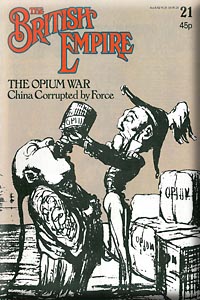 |
The Opium War: The dependence of the East Indies Company - and the British public - on Opium. The first attempts of the Company to trade with the unbending Chinese Emperor. Picture Essay - A Fruitless Mission: The hopeless efforts of Lord George Macartney to obtain a trade agreement from the aged Emperor Ch'ien-lung. Exporting the 'Pernicious Drug': The immensely profitable trade in opium smuggled into China from India to pay for tea. Picture Essay - Traders in Oblivion: How the opium was gathered, cured and shipped from Calcutta to the waiting addicts in China. The 'Barbarians' sweep to Victory: Chinese efforts to ban opium smuggling leads to a British invasion and, after a rapid campaign, to China's humiliation. |
||||
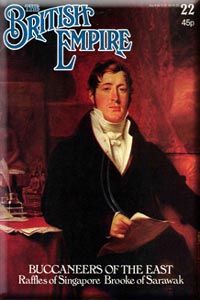 |
Buccaneers of the East: The men whose drive led to an unexpected expansion of the imperial frontier of the Far East. The Founder of Singapore: Thomas Stamford Raffles' career and his acquisition of one of the greatest ports of the East. Picture Essay - Raffles His administration of Java and Singapore and his work as a naturalist. The Legacy of Raffles: Singapore burgeons into a great trading port as British power slowly extends through all the Malayan peninsula. The White Rajah's of Sarawak: James Brooke's empire building in Borneo and his establishment of a dynasty remembered with affection in Sarawak. Picture Essay - Brooke Rajah Brooke's suppression of piracy and his failure to suppress - head-hunting King of the Cocos Islands: John Clunies-Ross takes possession of some remote Indian Ocean islands. |
||||
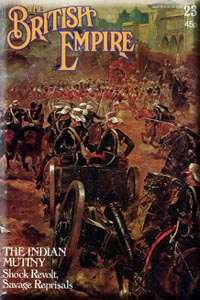 |
The Indian Mutiny: The causes of the great revolt, the first bloody outbreak in Meerut, and the rebel march to Delhi. Picture Essay - The Siege of Delhi: For months, an inadequate force of British and sepoys preserved a precarious position outside Delhi until heavy reinforcements allowed them to take the city. A Year of Bloodshed: Two other towns, Lucknow and Cawnpore - were centres of revolt before the start of the vengeful campaign which finally crushed the mutineers. Picture Essay - A Heritage of Anger: How Victorian artists portrayed the Great Mutiny as an epic tragedy. The End of the Devil's Wind: Queen Victoria's proclamation ends Company rule and places the government of India firmly in the hands of the Crown. |
||||
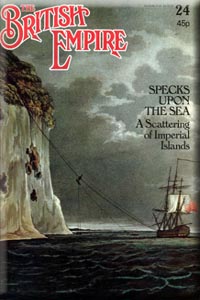 |
Specks Upon the Sea: A survey of the innumerable islands that became part of the Empire and some of the reasons why the British acquired them. Ascension and Tristan da Cunha Two of the world's remotest islands. St Helena Napoleon's place of exile. Mauritius Sugar Island in the Indian Ocean. Diamond Rock A Gibraltar of the West Indies. Nicobar, Andaman and Redonda Sweltering, lazy backwaters in the Indian Ocean. The 'Bounty' and Pitcairn The mutiny that led to the colonisation of Pitcairn. Fiji The 'Cannibal Isles'? |
||||
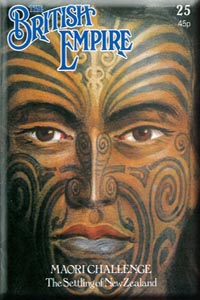 |
The Maori Challenge:The effect of the arrival of the first Europeans in New Zealand on the Maori inhabitants. Picture Essay - The Lost World of the Maoris: The life of the early 19th Century Maoris, as seen by an English Artist, when their ways were still much as they had been for hundreds of years. The Struggle for Possession: The conflicts between the two races that eventually flared into all out and prolonged war. Picture Essay - Taming the Land: The colonists whose land-clearing, building and farming achievements created the foundation of the modern nation of New Zealand. 'God's Own Country': The exhilaration of those caught up in the building of an egalitarian, politically mature, thriving community. |
||||
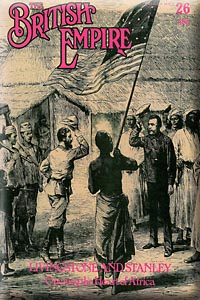 |
The Life and Explorations of Dr. Livingstone:The first of the epic travels into Africa by the most famous of all 19th Century explorers. Picture Essay - Momentous Meeting, Fruitless Search: Livingstone and Stanley meet; the Doctor's march to his death. Picture Essay - Livingstone: A Jaundiced View: Previously unpublished water-colours reveal that the adulation of Livingstone was not universal. Livingstone's heir: Stanley's organised explorations reveal the true geography of Central Africa... but his return from Darkest Africa brought only begrudging praise. Picture Essay - The Presumptious Mr. Stanley: Stanley's journey to 'relieve' a man who didn't need rescue.
|
||||
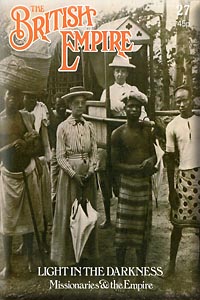 |
Light in the Darkness:The self-confident and, in retrospect, arrogant attempt of the missionaries to bring British religion and civilisation to non-Christian peoples. Picture Essay - 'From Greenland's Icy Mountains': Missionaries' publicity for their work in many parts of the world, answering - so they believed - the heathen's call. In Need of Protection: The ambivalent attitudes of missionaries in far away places who asked for government protection but when the gunboat or district officer arrived had second thoughts. Picture Essay - Little Pockets of Civilisation: The secondary work of the missionaries in spreading literacy, medicine and simple technologies. A Tea-Drinking Existence: The end of the missionaries' pioneering days. |
||||
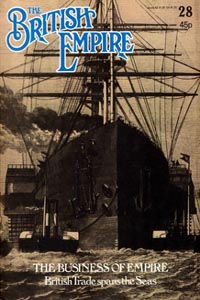 |
The Business of Empire: The enormous opportunity for world trade offered by Britain's command of the seas during the Napoleonic Wars, and how shrewd men developed trading skills. Picture Essay - The Racing Clippers: 'Iron men in wooden ships' drove beautiful vessels across the stormy seas to win the rewards of being the first in London with the fragrant new tea-crop. Discovering the Empire: The growing realisation that the previously ignored colonies were excellent prospects for profitable investment. The 'Great Eastern' With a vision far out-reaching the technical progress of his time, Isambard Kingdom Brunel built an enormous and terribly unlucky ship that, in effect, killed him. The Competition Stiffens: As other nations reached industrial maturity, Britain found that its markets, even in the Empire, were slipping. |
||||
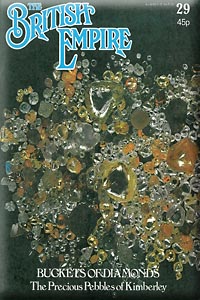 |
Buckets of Diamonds: The dramatic story of the discovery of diamonds in South Africa; the wealth that it brought to some and the misery to others; the changed fortunes of Cape Colony. Picture Essay - The Big Hole: The enormous excavation of the ancient, extinct volcano to secure the diamonds encased in the blue earth - left by an eruption that took place millions of years ago. The Great British Diamond Theft: The growing conflict between the diggers, who were largely British, and the Boers who claimed dominion over the diamond fields; the role of Cecil Rhodes. Picture Essay - The Cullinan Diamond The largest diamond ever found; how it was split into 105 pieces, some of which form part of the British Crown Jewels. |
||||
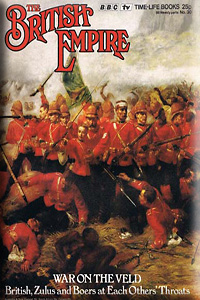 |
War on the Veldt: The arrival of British troops in southern Africa and their reception by the Boer farmers. Picture Essay - The Breaking of the Zulus: Isandhlwana, Rorke's Drift and Ulundi. The Boers Rebel: With Zululand quiet, the Boers revolt against the British and seize their independence by inflicting another stunning reversal on British troops at Majuba. |
||||
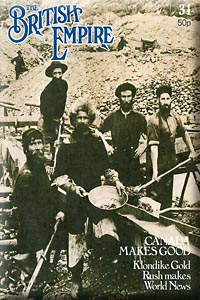 |
Canada Makes Good: The struggle to create a federated nation out of the various, widely separated colonies that made up British North America. Picture Essay - Canadian Pacific Railway: Despite repeated political and financial crises, the rails that linked the east and west coasts of Canada were finally completed. The Welding of the Nation: Sir John A. MacDonald, spurred by the vision of a united Canada, faced rebellions and political crises - apart from the building of a transcontinental railroad. Picture Essay - Gold Rush to the Klondike When the news of a gold strike in the remote Klondike region reached the outside world, a horde of fortune seekers pushed their way through impossible terrain in the pursuit of riches. Canada Comes of Age: Suddenly, after decades of slow progress, Canada begins to reap the harvest of success. |
||||
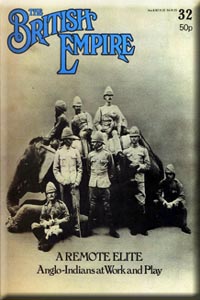 |
A Remote Elite: The Attitudes of those who came to administer India in the second half of the 19th Century. Picture Essay - POSH: The joys of the quick sea voyage to India. POSH via the newly opened Suez Canal. Picture Essay - Our Life in India: An album of photographs portraying Anglo-Indians at work and at ease. Asserting the Right to Rule: The self-righteousness of the British in India, reinforced by the attitudes of the memsahib, leads to a growing separation between the races. Picture Essay - The Stores: The founding of the famous Army and Navy Stores - suppliers to Officers and their families travelling to India. |
||||
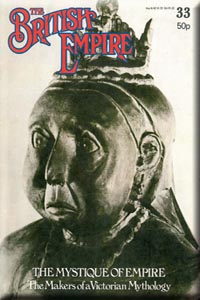 |
The Mystique of Empire: The imperial fever at the end of the 19th Century, its ideology and its leading practitioners. Picture Essay - School for Empire: Haileybury, once the East India Company College, became a public school and preserved its strong imperial associations. The Study of Patriotism:The ways in which imperial feeling was extolled in education and literature. Picture Essay - Victoria's 'Little Paradise': Osborne, the royal private home that acquired a special place in the heart of the Queen Empress. Penny Papers - Jingo Times: The diffusion of imperialism through the new, sensation seeking Press - and nostalgic popular songs of the music halls. |
||||
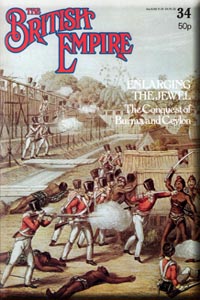 |
Enlarging the Jewel: A long history of Anglo-Burmese controversies culminates in the invasion of Burma by troops of the East India Company. Picture Essay - The First Burmese War: The Southern Campaign and capture of Rangoon. The Death of a Nation Despite victory in the First Burmese War there were two more campaigns before annexation was completed in 1886. Picture Essay - The Road to Mandalay: Life after the Third Burmese War. Take over in Ceylon: With the help of bribery and subversion, Britain succeeds in wresting Ceylon from the Dutch. Picture Essay - Tea: The most successful tea planter in Ceylon was Sir Thomas Lipton, who sold the profitable product in his own chain of shops. Disaster and Recovery: When a plant disease destroyed the coffee plantations of Ceylon, the introduction of tea-growing brought new prosperity to the island. |
||||
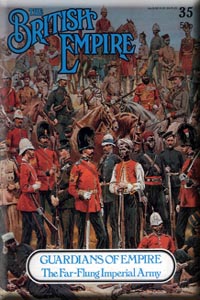 |
Guardians of Empire: The origins of the imperial army and the aims and attitudes that dominated it throughout the 19th Century. Picture Essay - Scenes from a Soldier's Life: Deeds of Derring-do from a Regency Picture and Verse story. Picture Essay - The Toy Soldier: Infantry Training according to an 1861 Drill Book. Picture Essay - Guns that Won the Empire: Rifles, side-arms, cannons and machine-guns that assured the British victories over native foes. Good Life and Reform: The army world in India - idyllic for most officers - and the late century reforms that prepared Britain for World War. |
||||
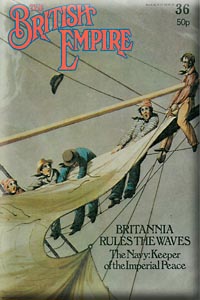 |
Britannia Rules the Waves: The Navy and its background as it stands on the threshold of a century of peace-keeping at sea. Picture Essay - A Sailor's Life: Until well into the 19th Century, the Navy offered a brutally tough existence for seamen. The Coming of Steam: Admirals growing old in peacetime office interminably blocked innovation - including the technical revolution promised by steam. Picture Essay - The Navy in the Crimea: In Britain's major 19th Century war, the Navy played a vital role in support of the Army. Unwieldy Guardian of the Pax: After 75 years of peace, the Navy, more concerned with display than action, at last found the reformer of which it was so badly in need - Admiral Fisher. |
||||
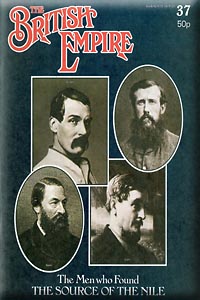 |
The Source of the Nile: The first journey by Richard Burton and John Speke to find a gaol that was to obsess British explorers for the next 30 years; their quarrel; Speke's discoveries with Grant and the last journeys of the Bakers. Picture Essay - The Secret Revealed: A pictorial record of the explorations by Speke and James Grant that found the Nile's source and of Baker, who charted much of its course. Picture Essay - A Romantic Hero in Decline: Richard Burton, explorer, adventurer, translator - who failed to achieve personal success in life. Picture Essay - Baker Pasha, Ruler of Equatoria: Samuel Baker's ill-fated attempt to wipe out the Arab-run slave-trade on the Upper Nile. The Search Ends: An assessment of what a great age of exploration had achieved and what remained to be done. |
||||
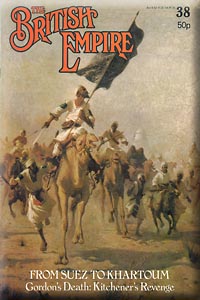 |
From Suez to Khartoum: Disraeli's acquisition of a controlling interest in the Suez Canal - the first step in Britain's ever deepening involvement in Egyptian affairs. Picture Essay - Rout and Revenge: The agonizingly slow advance of Wolseley's relief force up the Nile, Gordon's death at Khartoum at the hands of the Dervishes and Kitchener's bloody revenge at Omdurman 13 years later. Flashpoint at Fashoda: Kitchener's victory preceded a further advance up the Nile - this time to confront a French force that was threatening to seize the whole of the Upper Nile Valley for France. |
||||
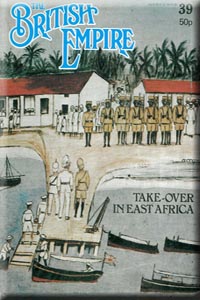 |
Take-Over in East Africa: From a position of influence only in Zanzibar and the Sudan, the demands of strategy lead Britain into Europe's scramble for African colonies. Picture Essay - Rescue from Bondage: To crush Arab slave-trade was a prime reason for the British presence in Zanzibar. Bargaining for Imperial Security: European politics eventually dictate the colonial boundaries in East Africa; Britain wins Kenya. Picture Essay - The Lunatic Line: An inefficient attempt to construct a railway inland to protect the source Playground for Aristocrats: The first wealthy settlers arrive in the new colonies. Picture Essay - The First Safaris: Hunting big game was a challenging and popular sport. The Halcyon Days: The coming of full-scale 'settlement' in East Africa lays the basis for future unrest. |
||||
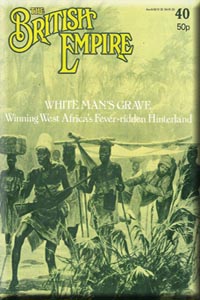 |
White Man's Grave: The disease-ridden West African coastline and the rise of the warlike Ashanti, who eventually the British into the interior. Picture Essay - The Ashanti War: In a brilliant piece of improvised campaigning, Sir Garnet Wolseley becomes an imperial hero by shattering the Ashanti. The Taming of the Interior: The final chapter in the struggle with the Ashanti and the way that the Royal Niger Company dragged an unwilling government into Nigeria. Picture Essay - Through African Eyes: Cartoon-like carvings of the Queen, and of Europeans who came to Africa, spotlight the impact made by the British rule. New Nation on the Niger: Sir Frederick Lugard welds warring tribes of the southern Sahara into a single unit. |
||||
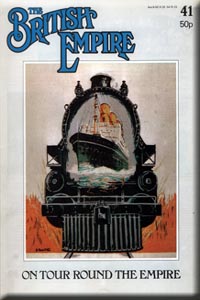 |
On Tour Round the Empire: British tourism from the days of the early explorers and the Grand Tour to the great age of Steam. Picture Essay - The Man from Cook's: How a travel agency's representative became a quasi-imperial figure, a plenipotentiary of British civilisation abroad. The Ubiquitious Englishman: Holiday with a Kodak: Passage to the Orient: Globe Trotters in Australia: Steel of Empire: With Love from Maude: Life on the Ocean Wave: The Craze of the Cruise: Pleasure for the Millions: |
||||
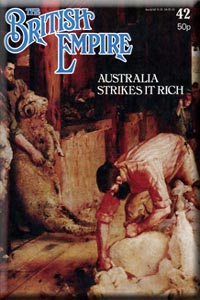 |
Australia Strikes it Rich: Australia is found to be 'Gold Country' and in the early 1850s becomes the California of The British Empire, with its own feverish gold rush, eager settlers and mushrooming cities. Picture Essay - Gold: Hysteria follows the discovery of gold in New South Wales and Victoria; whole towns become deserted; passages to Australia are booked out; diggers start grubbing in the earth. Out of Chaos, Unity Riding on the crest of economic expansions, Australia's five colonies bury their differences and become one nation. Picture Essay - Steel Lifeline: The rival railways bring wool from the outback and keep exports on the move to the coast. Picture Essay - Escape to the Sun The lure of Australia for the British immigrant before the Second World War. |
||||
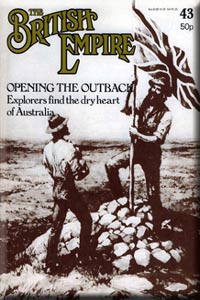 |
Opening the Outback: Heroic feats of early explorers carry the Union Jack west from Sydney into the hinterland and across the trackless expanses of South and Western Australia. Picture Essay - The First Australians: Introduction to the Aborigines, an astonishingly primitive people with complex and at times thoroughly crude customs. The Great Exploration Race: The stories relating the rival attempts to discover the secrets of Central and Northern Australia. Picture Essay - Disaster at Cooper's Creek: The tragicomedy of the most expensive and most disastrous expedition in the history of Australia. The End of the Dream: The explorers' day is done, settlers move in, everyday life replaces epic adventure. |
||||
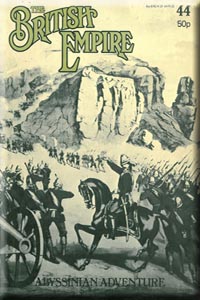 |
Abyssinian Adventure: To rescue a British consul and other European captives enchained in the mountain castle of the half-civilised Emperor of Abyssinia, Britain launched a full scale military invasion. With the news stories of a dozen top war correspondents flooding in, it attracted all the publicity of an adventure story come true. Picture Essay - The Road to Magdala: The course of the campaign described, with illustrations of the rusty railway from Bombay, Theodore's giant mortat and the actions that hit the headlines. The Conquering Hero: Napier became a Victorian hero, and his victory turned into an exercise in national self-congratulation. |
||||
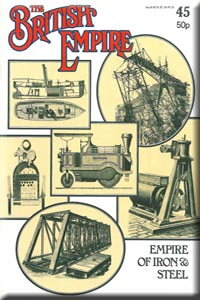 |
Empire of Iron and Steel: The missionary fervour of Britain's early engineers. Picture Essay - Power to Move Mountains: Glimpses of Victorian machines, some of them technical masterpieces, that were exported from Britain. A Wild Land Tamed: India transformed by the mammoth irrigation works, roads, railways, harbours and telegraph of British engineers. Picture Essay - The Welding of India: Chapters in the modernisation of a barren country including the pioneering Crompton road steamer. The Eighth Wonder of the World: The Aswan Dam on the Nile, the Victoria Bridge across the St. Lawrence and other miracles of British engineering. Cleopatra's Needle: The dramatic transporting of this obelisk to London in 1878. |
||||
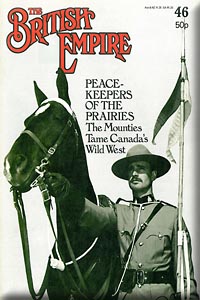 |
Peacekeepers of the Prairies: The origins of the North West Mounted Police, fromed to pacify Canada's Wild West, the vast, barely inhabited North-West Territories. Picture Essay - Cavalry for Peace: How the Mounties, a crack cavalry unit, established an astonishing and well-deserved reputation for good works. Peace with the Indians: The Mounies' part in incorporating, without serious bloodshed, nomadic Indian tribes into the framework of a white, Western state. Picture Essay - A Doomed Nation: A last glimpse of the Indian way of life and the sad results that followed the arrival of modern civilisation. The White Invasion: New duties for the Mounties as a rush of white settlers opened up the prairies. The Last Mounted Mounties: Horsemanship for the 'Musical Ride'. |
||||
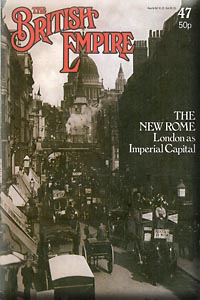 |
The New Rome - London as Imperial Capital: The largest city in the 19th Century world and how all lines of communication led to this, the New Rome, centre of the largest Empire ever. Picture Essay - The Hub of Empire: Imposing buildings, bustling streets, markets, docks, bridges and parks - all the magnificence and squalor of Victorian London. The Cracked Facade: Moral doubts, declining economic power, political isolation and growing disaffection in the colonies threaten the Empire and portend the day when London would no longer be an imperial capital. Picture Essay - Make-Believe in Mayfair: The fancy-dress ball. Picture Essay - The Naughty Nineties: Idols of the music halls and the cameras. |
||||
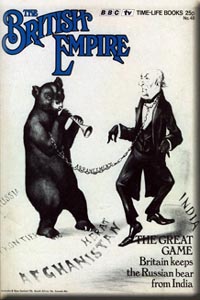 |
The Great Game: Political chess in Asia, played by Russia and Britain with India as one of the most important pieces on the board. Picture Essay - Kabul to Kandahar: One of the legends of British military history - the epic 300 mile march led by 'Bobs' Roberts across Afghanistan. Picture Essay - Futile Mission: One of the strangest expeditions ever undertaken by a British force, in which Colonel Younghusband found oddly submissive victims for a massacre in the never-never land of Tibet. Last Throw of the Dice: Britain's action to make Tibet secure against Russia turns out to have been unnecessary: Russia had no ambitions there in the first place. |
||||
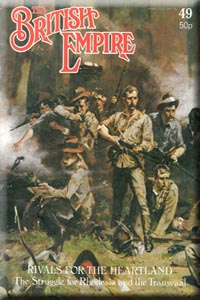 |
Rivals for the Heartland: Cecil Rhodes's ambitious dreams meet opposition from Kruger of the Transvaal and the fighting Matabele warriors. Africa's El Dorado: Fortune hunters in the gold-fields of Johannesburg. Picture Essay - The Making of Rhodesia: The Pioneer Column treks into Matabeleland with surprising ease, but then has to fight t preserve Rhodes's new colony. Jameson's Raid: Rhodes's ambitious attempt to take over the Transvaal by fomenting rebellion in Johannesburg comes to naught when Jameson's raid is smashed. |
||||
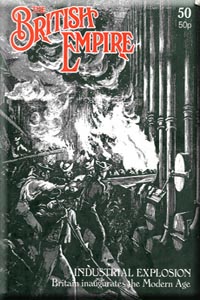 |
Industrial Explosion: The age of iron and steam, forerunner of modern industrial society, hit Britain with the force of an explosion, transforming her way of life almost overnight and making her the wealthiest, most powerful nation in the world. Picture Essay - The Great Exhibition: A look inside the Crystal Palace - the Cathedral of glass built for the Great Exhibition of 1851 - at the show put on by the workshop of the world. Industry and Empire: How Empire seemed increasingly important to Britain as her industrial supremacy was challenged by other rising nations. Picture Essay - Railway Madness: Alarm, novelty and excitement in the 1840s railway boom. |
||||
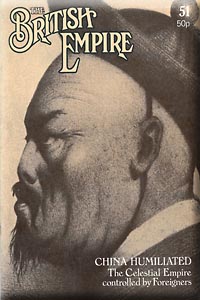 |
China Humiliated: After Britain's success in the Opium War, British officials in the East determine to open a still recalcitrant China to British diplomacy and trade. Picture Essay - The Struggle for Peking: In a swift and all-too-easy campaign, the British and French fight, burn and loot their way to China's capital. China awakened from the Past: The Chinese Dragon, prodded into wakefulness by the foreigners, prepares to take revenge on its tormentors. Picture Essay - The Boxer Rebellion: The ferocious Boxer rebels besiege the foreigners in Peking until Western victory delivers China once again into foreign hands. |
||||
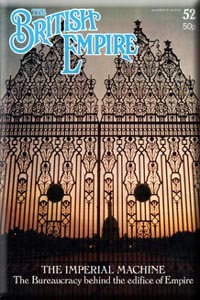 |
The Imperial Machine: Who ran The British Empire? The truth about the imperial machine is dispassionately revealed. Picture Essay - A Hotchpotch of Styles: Government houses and residencies were made in a hotchpotch of architectural styles from palatial mansions to crofter's cottages. Picture Essay - A The Crown Agents: The Paraphernalia of colonial government, from red tape to dredgers, and the work of the Crown Agents who supplied them. Servants of the Crown: The men who served their kind and country in many parts of the world and whether they benefitted the native peoples. |
||||
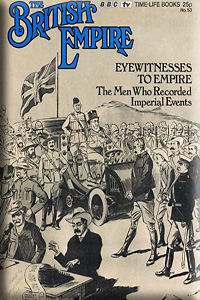 |
Eyewitnesses to Empire: The coming of a new breed of war correspondents who specialized in covering the "little wars" of the late 19th-Century Empire. Picture Essay - Thomas Baines, Explorer with an Easel: The unassuming, unlucky artist, whose work has left a colourful record of the exotic lands of Africa and Australia. The Men who made Headlines: The staggering feats of endurance undertaken by the men dedicated to getting the news back home, including Archibald Forbes, Frederick Villiers and Melton Prior. Picture Essay - "Special Artist": For over 40 years, "special artists" like Melton Prior provided magazines at home with the visual material that gave another dimension to the correspondents' reports. A Perilous Profession: Egypt and the Sudan drew scores of correspondents and artists at the end of the Nineteenth Century, some of whom died from wounds or disease. Picture Essay - The Camera's Eye: The work of Horace Nicholls during the Boer War. Picture Essay - A Lighter Touch: Some of Leonard Raven-Hill's sketches made en route to the 1903 Durbar. |
||||
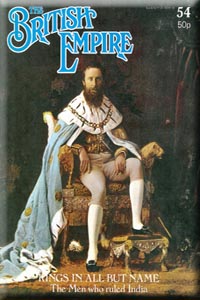 |
Kings in All but Name: How ordinary Englishmen, appointed by a trading company and later by the British Crown, were invested with all the trappings of Oriental suzerainty. Picture Essay - A The Crown Agents: The Paraphernalia of colonial government, from red tape to dredgers, and the work of the Crown Agents who supplied them. Would-be Autocrats: Several Viceroys learned the hard way the limits of their power. Picture Essay - 'Up the Country' with the Edens: Letters from a Governor-General's sister and companion. Picture Essay - Viceroy On Show and Off Duty: Scenes from the photograph album of a 19th Century Viceroy. Ceremonial Glitter: Behind the facade of viceregal magnificence, what was the substance of power. Picture Essay - The Monuments of British Power: Government House, Calcutta and the Viceregal Lodge, Simla.
|
||||
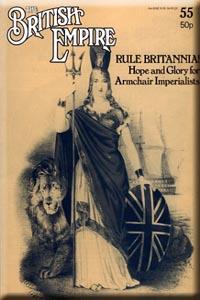 |
Rule Britannia: The novels, pulp magazines and poems that reflected the imperial enthusiasm of the late 19th Century with tales of derring-do in the Empire. Picture Essay - Empire in the Limelight: The fad for all things imperial spread readily to theatre; one musical on a Chinese theme, San Toy, proved particularly successful. Awakening to Imperial Reality: The novels of life in India - written by those with personal experience of India - highlighted the difficulties of Britain's relations with the sub-continent. |
||||
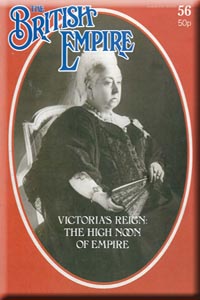 |
High Noon of Empire: The gathering of peoples from all over the Empire to take part in celebrations that commemorated the Diamond Jubilee, the 60th year of Queen Victoria's reign. Picture Essay - London's Great Day: The great Jubilee procession of June 22nd, 1897, reported in photographs and paintings. The Spirit of Empire: A recall of the extent of the largest Empire the world had ever seen and what it meant to those alive. The British Empire 1897: A map showing the world splashed with imperial red, together with statistics of area and population of the various possessions. Picture Essay - A Queen's Story: An album of pictures tracing Victoria's life from childhood through nearly eight decades. The Spithead Review: The Home Fleet, arrayed in columns extending for miles, gave proof to assembled dignataries that Britain ruled the waves. |
||||
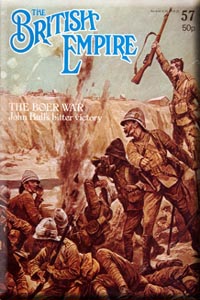 |
The Boer War: The futile beginning of hostilities in which the British offer themselves as sitting targets for siege practice at 3 towns on the border. Picture Essay - The Death and Glory Boys: Some of the work from the war artists' portfolios painted in the popular Victorian Heroic style, an art form that glorified British defeats as moments of heroism. All Out War: The big set pieces of the war from the British disasters of Black Week to the near-crushing of the Boer republics by conventional warfare. Picture Essay - The War of Words: The propaganda campaigns of Boers and British with both sides emerging as villains and murderers. The Bitter End: Guerilla war, concentration camps, scorched earth policies all designed to draw the bitter war to an end. |
||||
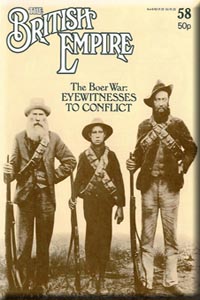 |
Eyewitnesses to Conflict:Eyewitness accounts from both Boer and British sides reveal some of the buffooneries and tragedies of the war's campaigning phase. Picture Essay - An Army's Might, a Nation's Will: A photograph album of the war as it was experienced by ordinary men of both nations. A Nation Crushed: The passion and bitterness of the guerilla war, and the scorched earth tactics required to humble a proud and stubborn nation. Picture Essay - The Coming of the Concentration Camp: Inside views of an unpleasant 20th Century institution used by the British. Picture Essay - Peace at Last: The emotional end to a war that had been both militarily and morally exhausting. |
||||
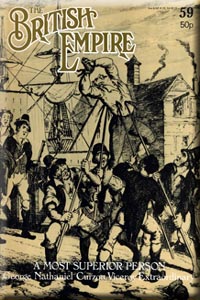 |
Ireland - The Tortured Colony: Over Ireland's first six centuries as a colony of Britain, social, religious and racial differences became so deeply embedded that any attempt to create a united Irish nation was doomed. Picture Essay - The Great Famine: A gruesome catastrophe that soured relations between Britain and Ireland in the 19th Century and added a grim determination to Irish nationalism. Moderation or Violence: The fateful struggle fought between moderates and extremists, and in the mind of Charles Stewart Parnell, for a constitutional or a revolutionary solution to Irish problems. Picture Essay - Ireland Split Asunder: Extremist and violent scenes in the streets of Belfast and Dublin. Two Nations in One Island: The final nemesis of Britain's failure either to conquer Ireland effectively or to colonise her completely: a partial solution to the Irish Question. |
||||
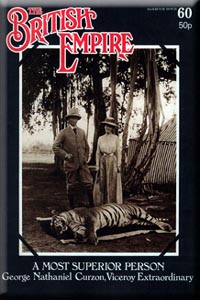 |
A Most Superior Person: George Nathaniel Curzon's brilliant early years, his towering ambition to rule India, his work to achieve his aim. Picture Essay - The Great Delhi Durbar: The glittering highpoint of Curzon's Viceroyalty in which he sought, in lavish ceremony, to give British rule the stamp of permanence. A Tarnished Brilliance: Curzon's last years as Viceroy, his increasing conflict with colleagues in India and at home and his failure to achieve the rewards for which he believed himself destined. |
||||
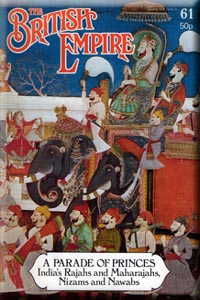 |
A Parade of Princes: The princes of India, ranging from millionaires to demigods, are reviewed in a quick sketch that gives their history, assesses their significance and describes their astonishing magnificence. Picture Essay - Benighted Playboys, Enlightened Despots: Glimpses of the palaces, family life, ceremonies, bejewelled persons and vices and virtues of the princes.. Medieval Monarchs in the 20th Century: The decline and fall of some of the last feudal autocrats to survive in the modern world. |
||||
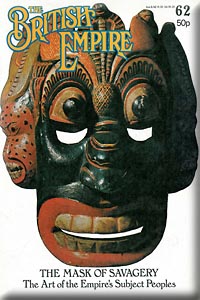 |
The Mask of Savagery: The change in attitude - from outright rejection to admiration - towards the art of Britain's imperial subjects. Canada: Totems in wood and stone. Egypt: The treasures of the Pharoahs. Benin: Classic works in bronze and ivory. India: Monuments to artistic endeavour. Burma and Ceylon: Golden pagodas, savage masks. Java: Puppetry and music. Oceania: Noble savagery in the South Seas. |
||||
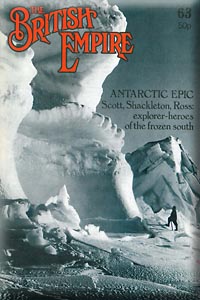 |
Antarctic Epic: British explorers of the great Antarctic continent, and how the immensity of their task turned both their successes adn their failures into epics. The Glorious Defeat of Captain Scott: The moving story of Captain Scott's defeat at the Pole and his personal struggle with death, dramatically captured in photographs taken by various members of the expedition, including Scott himself. Heroes to the Last: The heroic age of Antarctic exploration and its end with the coming of snow cats, centrally heated pre-fabs and all the other paraphernalia of modern technology. |
||||
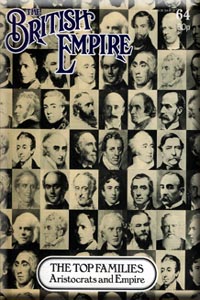 |
The Top Families: The origins, relationships and aspirations of the 5,000 landed families who ruled Britain and the Empire until the beginning of the Twentieth Century. Picture Essay - A Family Affair: A profile of the Elgins of Scotland, who - often at high personal cost - maintained a long family tradition of top level imperial service. Dozens of Cousins: The Great Reform Bill of 1832 was the first step on the road to universal franchise - but real power remained in the hands of the top families and their favoured 'cousins'. Picture Essay - Seedbed of the Imperial Elite: Some of the institutions that moulded the men in chief colonial posts. The Last of the Line: Descendants of families that had helped to shape and run the Empire were still in harness when the end of imperial rule came after the Second World War. |
||||
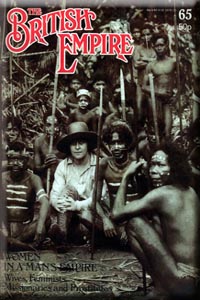 |
Women in a Man's Empire: The women who left their kith and kin to travel across the world to make a new life for their families and a new country for their Empire. Picture Essay - Women with a Mission: Groups of women who wanted to play more than a merely supporting role on the stage of Empire: Missionaries, adventurers and nurses. White Women against a Dusky Background: India and Africa, lands where women had to hold up the lamp of Victorian civilisation in continents of heathens. Picture Essay - Marianne North: The gentle painter of flowers who managed to visit every continent and most of the countries of the Empire during her sedate travels. Beating at the Gates of Power: Two women who, in their different ways, wanted to do more than live in the Empire - they wanted to change it. |
||||
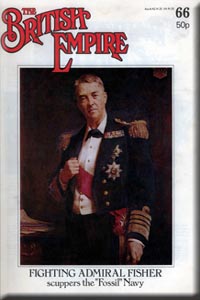 |
Scuppering the 'Fossil' Navy: At the turn of the century, the Royal Navy prided itself on ruling the waves. But to Sir John Fisher it appeared as a picturesque and petrified fossil. Picture Essay - Fisher's Landlubber Sailors: New shore-based training establishments are set up for officers and ratings and the lower deck gets a new deal. A Hurricane Hits the Admiralty: Ships, officers, traditions - all feel the cyclonic effect of Fisher's reforming zeal. Picture Essay - The Fighting Fleet: Determined to provide Britain with the world's most powerful navy, fisher launches a revolution in warship design. Meeting the German Menace - 1915: Fisher clashes with another self-willed and tempestuous giant - Winston Churchill. Fisher's Final Fling: A vain bid for autonomy. |
||||
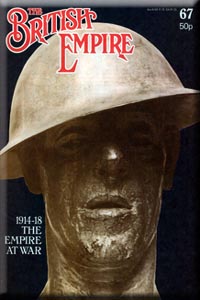 |
1914 - 1918 The Empire at War: The massive contributions of India and the white Dominions to Britain's military strength in the First World War. Picture Essay - Western Front: Glimpses of key actions fought by Empire troops in France and Belgium. The Battle and the Honours War as a catalyst of change and how the sharing of the honours loosened the bonds of Empire. |
||||
 |
1914 - 1918 The War Overseas: While Britain hurls the bulk of her forces against the Germans in Europe, the Empire rallies to her cause elsewhere. Picture Essay - Gallipoli: Empire troops share heroism and slaughter on the bloody beaches of Gallipoli. Picture Essay - Jungle War in East Africa: A former enemy leads the fight on Britain's behalf in the tropical jungles and disease-ridden swamps of East Africa. Picture Essay - Sea Raiders: Triumph follows humiliation for the Royal Navy - and the Australians win a great victory. |
||||
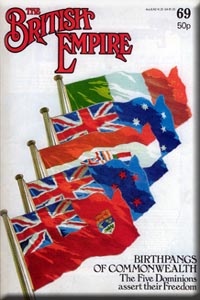 |
Birthpangs of Commonwealth: While Britain's Dominions manouevre for increased say in their own affairs. Ireland fights a bloody war to free herself from Britain. Picture Essay - Civil War in Ireland: The 1921 treaty between Britain and Ireland splits the Irish Free State into two warring factions. Death Knell of the Empire: Britain agrees to confer her Dominions the new status of independent states within the Commonwealth of Nations. Picture Essay - It's Not Cricket: The 'bodyline bowling' controversy erupts into a diplomatic crisis between Britain and Australia. The Last Achievement: Commonwealth countries bury their differences in the Second World War. |
||||
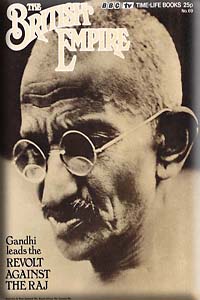 |
Revolt Against the Raj:The seed of revolt are sown and the British begin to realize that their Empire in India will not last for ever. Picture Essay - The Politics of Disaster: How the British Empire coped with famine and plague and what happened when Indians resented their high-handed methods. India Claims Nationhood:India slowly but inexorably discovers a pride in herself, guided by strong leaders who vocalize her desire for freedom. Picture Essay - Gandhi: The Great Soul: The extraordinary achievement of Mahatma Gandhi, the scrawny little man in a peasant loin-cloth who took on the Raj single-handed. The End of the Affair: Independence is in sight. Now it is only a matter of time before the British finally leave India. |
||||
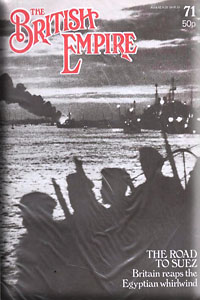 |
The Road to Suez:When Britain took over Egypt in 1882, the British were at the height of their prestige, and the Egyptians lay scorned and despised and without hope. Picture Essay - Egypt's Bright Hope: Farouk's accession to the Egyptian throne temporarily restores his people's faith in national revival - until he succumbs to a life of dissipation and debauchery. Swansong of British Imperialism: The nationalist takeover in 1952 prepares the way for a showdown between Nasser and Eden. Picture Essay - Suez 1956: Aided by France and Israel, Britain tries to re-impose her will on the Egyptians and receives one of her bitterest and most decisive defeats. The Slowly Fading Ghosts: Britain and Egypt lay the ghosts of Suez amid scenes of mourning for President Nasser. |
||||
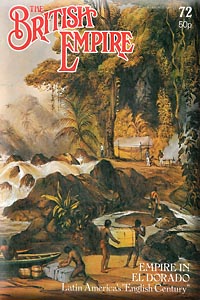 |
Empire in El Dorado:Britain's disastrous attempts to gain a military Empire in Latin America and her enormous success in creating an economic bonanza. Picture Essay - Into Guiana: The story of Britain's small colony on the north-east coast of the continent, illustrated by the romantic paintings of the artist, Charles Bentley. Under the Union Jack: How Britain gained her two small red patches on the Latin America map and the part they played in the history of the Empire. Picture Essay - The British Boom: Ports, railways and champter-ports - Britain's biggest market during the 19th Century was the emergent countries of Latin America. The English Century: Though Latin America was never part of the Empire, thousands of British settlers, merchants, bankers and technicians played their part in the development of the continent during the 19th Century. |
||||
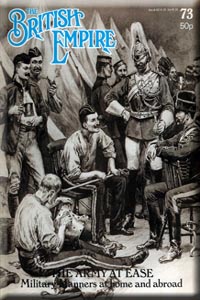 |
The Army at Ease: When it was not campaigning against rebellious colonial subjects, the Army of Victorian Britain was a dull and complacent institution, fettered to outworn traditions and scorned or ignored by the public. Picture Essay - Work, Sport and Play: Army life for officers - whether in Colchester or Cairo - was simply a repetition of the gentlemanly routine on which they had been nurtured as civilians. For other ranks it was hard, dreary and often brutal. Picture Essay - The Royal Tournament: Originally organised with the modest aim of arousing public interest in the Army, the Royal Tournament had become by the end of the 19th Century a graphic affirmation of the imperial ideal. Heroes of the Nation: Haunted by the spectre of an expansionist Germany and inflamed by the Boer challenge to British supremacy, a jingoistic British public raises the once despised Tommy to the status of national hero. |
||||
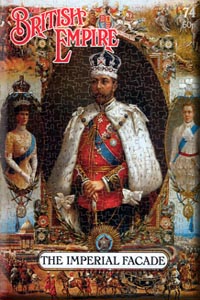 |
The Imperial Facade: Despite having won the first world war and the empire being larger than ever, the imperial structure was to prove no more than a glittering facade. Picture Essay - Royal Tourist: The Prince of Wales tours the Empire. The Machinery of Empire Attempts to draw the dominions closer to Britain founder. Picture Essay - Medals of Empire: The shining rewards for service. Forging the Family Bonds: Literature, films, radio and air travel hold the bonds of Empire together. Picture Essay - Be Prepared: Baden-Powell's Scout Movement. The Decline of British Influence: The drives towards imperial de-centralisation. Picture Essay - The New Pioneers: Trail Blazing Aviators. The Final Curtain: End of the Imperial show. |
||||
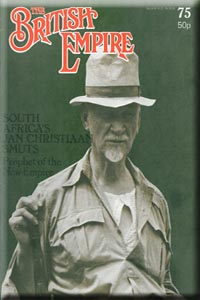 |
Smuts: Prophet of the New Empire: Jan Christian Smuts, a young Boer Lawyer, takes up arms to resist the might of The British Empire and proclaim a new ideal British Commonwealth Picture Essay - Into the Awful Desert: Troops from the fledgling Union of South Africa fight Britain's cause in the First World War. Years of Trial and Victory: Praised for his wise international diplomacy, Smuts becomes the focus of controversy and conflict in his own country. Picture Essay - The Coming of Apartheid: New men with a new and ruthless concept of race relations assume power in South Africa. The Final Trek: With his policies rejected by the electorate and his health failing, Smuts in his last years seeks consolation outside politics. |
||||
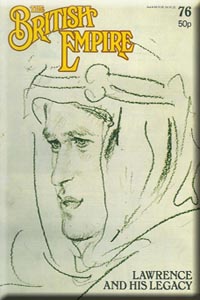 |
Lawrence and his Legacy The story of how Britain helped the Arabs in their fight against the Turks, and how an unprepossessing young captain became a legend. Picture Essay - The Legend of Lawrence: Illustrated with some of his own pictures, an account of Lawrence's daring exploits in the deserts of Arabia - activities that turned him into a hero to the British. Kingdom's Built Upon Sand: After the glory of the desert campaigns, the reckoning. At the Paris Peace Conference of 1919, the Arabs discovered how hollow were British promises. |
||||
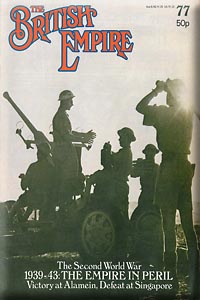 |
The Empire in Peril Britain goes to war with Nazi Germany and the overseas Dominions range themselves on the side of the Mother country. Picture Essay - First of the Imperial Few: Pilots from all parts of the Empire slow their heroism in the Battle of Britain. An Appeal to the Empire: Winston Churchill urges the Empire to concentrate its energies and resources on securing victory in Europe. Picture Essay - The War in the Desert: British and Empire forces throw Rommel's Afrika Korps into retreat at El Alamein. Shadow of the Rising Sun: Preoccupied with Europe and the Middle East, British planners neglect the Japanese threat to Malaya and Singapore. Picture Essay - Disaster in the Far East: The Japanese occupy Singapore - one of the worst military and political disasters for Britain. |
||||
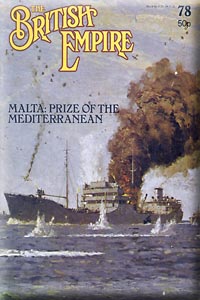 |
Prize of the Mediterranean In 1798, Britain extended her 'special and temporary' protection to Malta as part of the fight against a common enemy - Napoleon Bonaparte. The island was still under British protection when another common enemy had to be resisted nearly a century and a half later. Picture Essay - Minorca - the other Malta: The strategic Mediterranean base of the 18th Century, finally lost to Spain in 1802. Picture Essay - His Majesty's Devoted Island: Malta endures bombing and starvation during the Second World War, winning the admiration of the Empire and receiving a uinque honour from King George VI. Malta takes her Revenge: After her days of peril and privation, the George Cross island becomes the key to a dramatic new Allied offensive against the Axis powers. |
||||
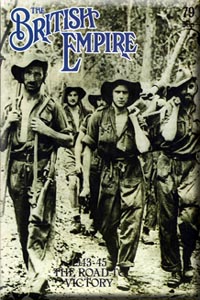 |
1943 - 1945 - The Road to Victory: By the beginning of 1943, Empire forces were on the offensive, chasing the remnants of Rommel's shattered Afrika Korps into Tunisia and striking back against the Japanese in Burma. The Lion Trainer: An unorthodox and dynamic military commander, General Orde Wingate, leads a legendary force of jungle fighters - the Chindits - against the Japanese. The Other War: Churchill is caricatured in Japanese propaganda leaflets smuggled into India, while Australia wages its own war of words against the Japanese invaders in New Guinea. Operation Overlord: British, Canadian and American forces storm their way ashore at Normandy after the greatest amphibious operation in history. |
||||
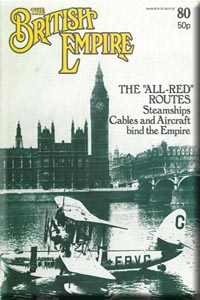 |
The All Red Routes: Britain led the world throughout the 19th Century in the development of post and telegraph services. The 'All-Red' routes spread out from London, criss-crossing the Empire and reducing the barriers of time and space between the colonies and the mother country. Picture Essay - A Postal Service for the People: A popular and efficient postal service develops in Britain and grows to embrace the Empire. From the Ocean Depths to the Clouds: Submarine telegraph cables revolutionize imperial communications, but within two generations wireless and the aeroplane have an even more drastic impact. |
||||
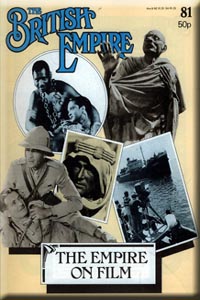 |
The Empire on Film: The early days of sound cinema when the Empire was seen aas little more than a source of stirring escapist romances. Picture Essay - The Romantic Image: Four inter-war films that gloried in the stories of men facing fearful odds for the honour of King and Country. Return to Reality: The war brings an increasing interest in real events, and film-makers working in the field bring a new realism to cinema views of the Empire. Picture Essay - The End of the Raj: Two films - Bhowani Junction and Nine Hours to Rama - exploit the dramatic events of Indian Independence in 1947. The Imperial Epic: The big screen gives new life to imperial history, presented outstandingly in Lawrence and Khartoum. |
||||
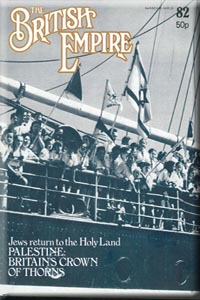 |
Palestine: Britain's Crown of Thorns: Britain's decision to back the return of the Jews to Palestine - the birth of an insoluble dilemma. Picture Essay - Return from Diaspora: Jews returning to their historical homeland find themselves in increasingly violent conflict with local Arabs. Terror and Counter-Terror: The strife of the 1930s in Palestine and Britain's inability to control the situation. Picture Essay - Finale with Bloodshed: The Jews fight the British, themselves and the Arabs as Britain decides to escape from the thankless task of governing the ungovernable. The Birth of Israel: A new Jewish nation emerges in a welter of bloodshed to continue a struggle for survival that shows no sign of ending. |
||||
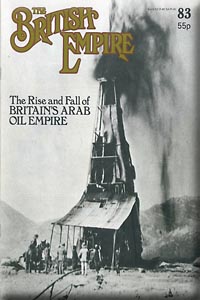 |
Britain's Arabian Oil Empire: A British oil prospector strikes it rich in Iran and opens up a fresh era in Britain's imperial history. Now, Britain was concerned with far more than the protection of the route to India. Picture Essay - The Battle of Aden: A former outpost of the British Raj, Aden becomes the embattled bulwark of Britain's Middle East possessions with British soldiers and their families as hostages. Britain Pulls out of Arabia: Unwilling any longer to stand against the fierce tidal wave of Arab nationalism, Britain cuts her losses in Arabia and the Persian Gulf and moves out. |
||||
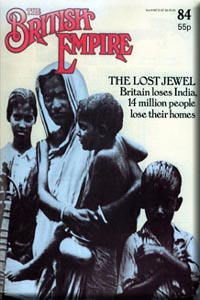 |
The Lost Jewel: The situation in India on the outbreak of the Second World War and what happened when the British continued to ignore the ground swell of nationalism sweeping the sub-continent. Picture Essay - The Heirs of Gandhi: Three men - Nehru, Bose and Jinnah - who in their different ways evolved out of the non-violent protest movement launched by Mahatma Gandhi. The Last Days of the British Raj: The Labour government of 1945 at last decides to give India her freedom. But how will they hand over the country - united or torn along religious lines? Picture Essay - The Bloody Birth of Two Nations: The cost in human misery of the politicians' decisions in 1947. |
||||
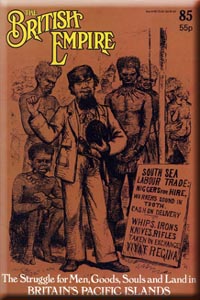 |
Britain's Pacific Islands: The first approaches by the British to the islands that lay north and east of Australia and the beginnings of annexation. Picture Essay - Australia's Isle of Wight: With the acquisition of New Guinea - vital, many thought, for safeguarding Australia's frontiers - an expedition arrives to assess the area. The Making of Island Nations: British and Australian administration of the Empire's island dependencies leads several of them to independence. |
||||
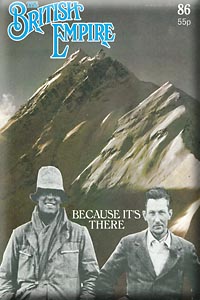 |
Because it's there: The 19th Century background to the British habit of looking for - and exploring - the most remote areas of the world. Picture Essay - Assault on Everest: The tragic effort to scale Mount Everest in 1924 which resulted in the disappearance of Irving and Mallory, as seen through the lens of the photographer, Captain John Noel. The Greatest Conquests: The rugged individualism of seafarer the late Sir Francis Chichester compared with the teamwork that took the Union Jack to the top of Everest. |
||||
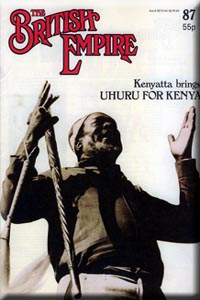 |
Uhuru for Kenya: Weary and resentful of European domination, Kenya's Africans take up the cry of 'Uhuru' - Freedom - and focus their hopes on one man: Jomo Kenyatta. Picture Essay - Mau Mau: Militants among the Kikuyu tribe wage a barbaric terrorist war against whites and Africans alike in their determination to drive out the settlers. Journey to the Promised Land: The settlers win their war against the Mau Mau, but nothing can prevent the African advance to majority rule. Picture Essay - Burning Spear: Feared and detested by the whites as the leader of Mau Mau, Jomo Kenyatta graduates from prison to the Prime-Ministership of independent Kenya. |
||||
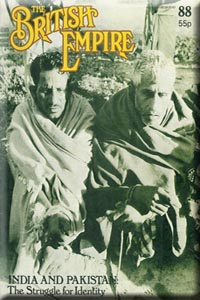 |
India and Pakistan - The Struggle for Identity:Pakistan's unhappy attempts to set up a democracy and India's early years under the leadership of Jawaharlal Nehru. Picture Essay - India at War: The new country of India finds herself at war twice during the sixties - with her neighbours China and Pakistan. The Rule of Indira Gandhi: Mrs Gandhi, elected in 1965 almost entirely because she was the daughter of Nehru, had to prove herself while facing both trouble in her own country and the war between the two wings of Pakistan. Picture Essay - Bangladesh: East Pakistan declares its independence as the new country of Bangladesh and one of the bitterest wars in modern times breaks out. A Continent in Collapse: The breakaway of Bangladesh means that Pakistan lost the fight to remain as one country. Might India go the same way?
|
||||
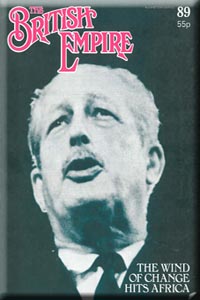 |
Africa's Wind of Change:Pakistan's unhappy attempts to set up a democracy and India's early years under the leadership of Jawaharlal NehruIn 1960 British Prime Minister Harold Macmillan noted 'the wind of change' stirring in Africa. Within five years it had swept away the last vestiges of British rule in the continent. Picture Essay - Mixed Harvest: Long overdue attempts to develop the vast economic potential of British possessions in Africa yield a mixed harvest of failure and achievement. Saturday's Child Comes Home: Kwame Nkrumah returns to the Gold Coast as the hope of white liberals and black nationalists. Picture Essay - The Redeemer: Having won independence for Ghana, Kwame Nkrumah turns his attention to the rest of Africa. Breaking the White Barrier: A group of powerful and determined nationalist leaders mount the assault against white rule in East and Central Africa. Picture Essay - Angry Partners: The rise and fall of the strife-torn Central African Federation. |
||||
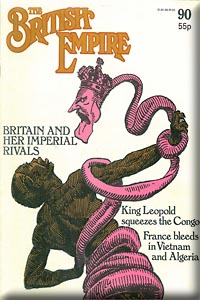 |
Britain and her Imperial Rivals:Britain's early Empire is established in the face of prior claims to overseas territory made by Spain, Portugal and Holland. Picture Essay - The Dutch Traders: In the East Indies, the Dutch oust the Portugese, prevent British incursion and establish a successful commercial empire that lasts for over 200 years. The Rush for Colonies: Britain, supreme overseas in the early 19th Century, is challenged by ambitious powers with very different ideas about controlling their imperial territories. Picture Essay - France's Bloody Retreat: France loses the battle to retain Vietnam and is brought near to civil war by unrest in Algeria. A Not-So-Bitter End: By comparison with her less adaptable rivals, Britain's own retreat from Empire seems a relatively peaceful affair. |
||||
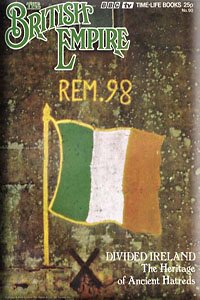 |
Divided Ireland: In 1921 the British government tried to satisfy Catholic nationalists and Protestant loyalists by dividing Ireland between them. But it was a prescription for disaster. Picture Essay: The Orange and the Green: Ritualistic parades and emotive wall slogans help to keep alive the traditions - and prejudices - of Ulster's divided people. The Sectarian Fever Rises: Attempts to bury Ulster's sectarian past create new and even more violent conflicts. Picture Essay: War on the Streets: Civil rights protests burst into open warfare and British troops are drafted into the streets of Londonderry and Belfast. The Westminster Government Steps In: Faced with mounting terrorism, the British government imposes direct rule on the province. |
||||
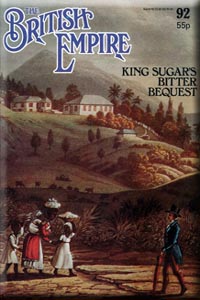 |
King Sugar's Bitter Bequest: Angered by the abolition of slavery and the elimination of preferences for their produce. British sugar planters in the 19th Century Caribbean accuse London of betrayal. Picture Essay - Declining Splendour: In spite of reduced profits, the planters still manage to live in sumptuous style. The New Slavery: The estate owners import thousands of labourers to supplant their former slaves - and create a new form of bondage. Picture Essay - The Fruits of Progress: New crops appear in the West Indies to challenge the traditional supremacy of sugar. The Nationalist Upsurge: After the First World War, Britain faces new demands from her Caribbean Empire. Picture Essay - Guyana - New Nation in Ferment: Racial and political tensions explode in the mainland colony of British Guiana.
|
||||
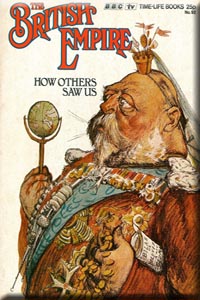 |
How Others Saw Us: While Britain's Empire was extending by leaps and bounds, other nations, especially France, were growing increasingly angry at Britain's continuing successes in the colonial race. Picture Essay - The Brutish British: Cartoons from the world's press show how everyone - apart from the British - saw the Boer War as a brutal attempt to smash a small nation and grab its wealth. May God Punish England: As Germany begins her policy of building up a colonial empire, invective against the British reaches a new height. Picture Essay - Ohm Kruger: Goebbels's masterly propaganda film, produced during the Second World War, twists well-known British characters into grotesque caricatures. Capitalist Exploiter of the Foreign Masses: As Britain divests herself of her Empire during the 20th Century only Communist Russia attacks her on the grounds that she still has an economic Empire.
|
||||
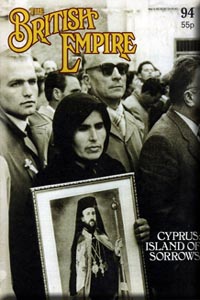 |
Cyprus - Island of Sorrows: British and Cypriots alike were delighted when Disraeli acquired Cyprus from the Sultan of Turkey in 1878. But the mood was short lived and within 50 years the island had become a political battle-ground. Picture Essay - Island at War: In 1955 Greek Cypriots, determined to win Enosis - Union - with Greece, launch a guerilla war against the British. The British Pull Out: With Cyprus locked in conflict between Greeks, Turks and British, Britain decides to grant the island independence. Picture Essay - Bloody Christmas: On Christmas Eve, 1963, Greek and Turkish Cypriots plunge into a bloody civil war.
|
||||
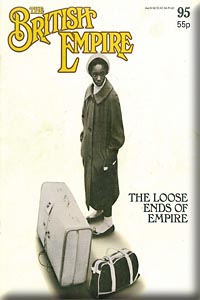 |
The Loose Ends of Empire: Although The British Empire is a fading memory, Britain's imperial past continues to create problems at home and abroad. Picture Essay - UDI: Britain's remaining colony in Africa launched a rebellion and declared Unilateral Declaration of Independence. Picture Essay - The Empire Comes to Britain: Social conflict and political controversy break out as thousands of Commonwealth citizens flock to Britain.
|
||||
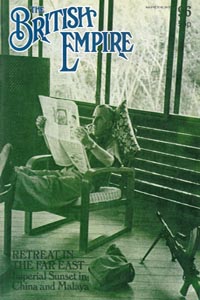 |
Retreat in the Far East: Preoccupied with problems elsewhere in the world, Britain gradually loses her supremacy in the Far East during the first half of the 20th Century. Picture Essay - Battle Zone: Britain watches anxiously as her vast business interests in Shanghai are threatened by the escalating conflict between China and Japan. Clash of the Island Empires: Once a close ally and admirer of The British Empire, Japan becomes an implacable foe. Picture Essay - Malayan Emergency: British forces fight a prolonged but successful campaign against Communist rebels in Malaya. The Last Confrontation: Indonesia threaten the newly independent Federation of Malaysia - and Britain engages in her final Far Eastern struggle. 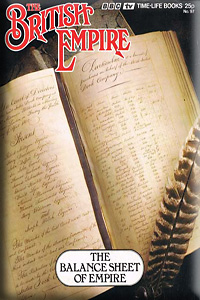 Governors and Governed:The transfer of British methods of government to the overseas colonies and their effect on the subject peoples. The Civilizing Mission: Imperialism is harnessed to the crusade for men's souls. Imperial Market Place: The financial profit and loss of running the British Empire. The Naked Emperor: For Britain, the end of Empire has meant a new and sometimes painful readjustment of attitudes and objectives. Conquerors and Profiteers: An assessment of some of the more dubious aspects of Empire. 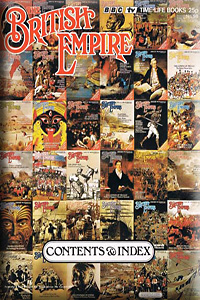 |
Armed Forces | Art and Culture | Articles | Biographies | Colonies | Discussion | Glossary | Home | Library | Links | Map Room | Sources and Media | Science and Technology | Search | Student Zone | Timelines | TV & Film | Wargames